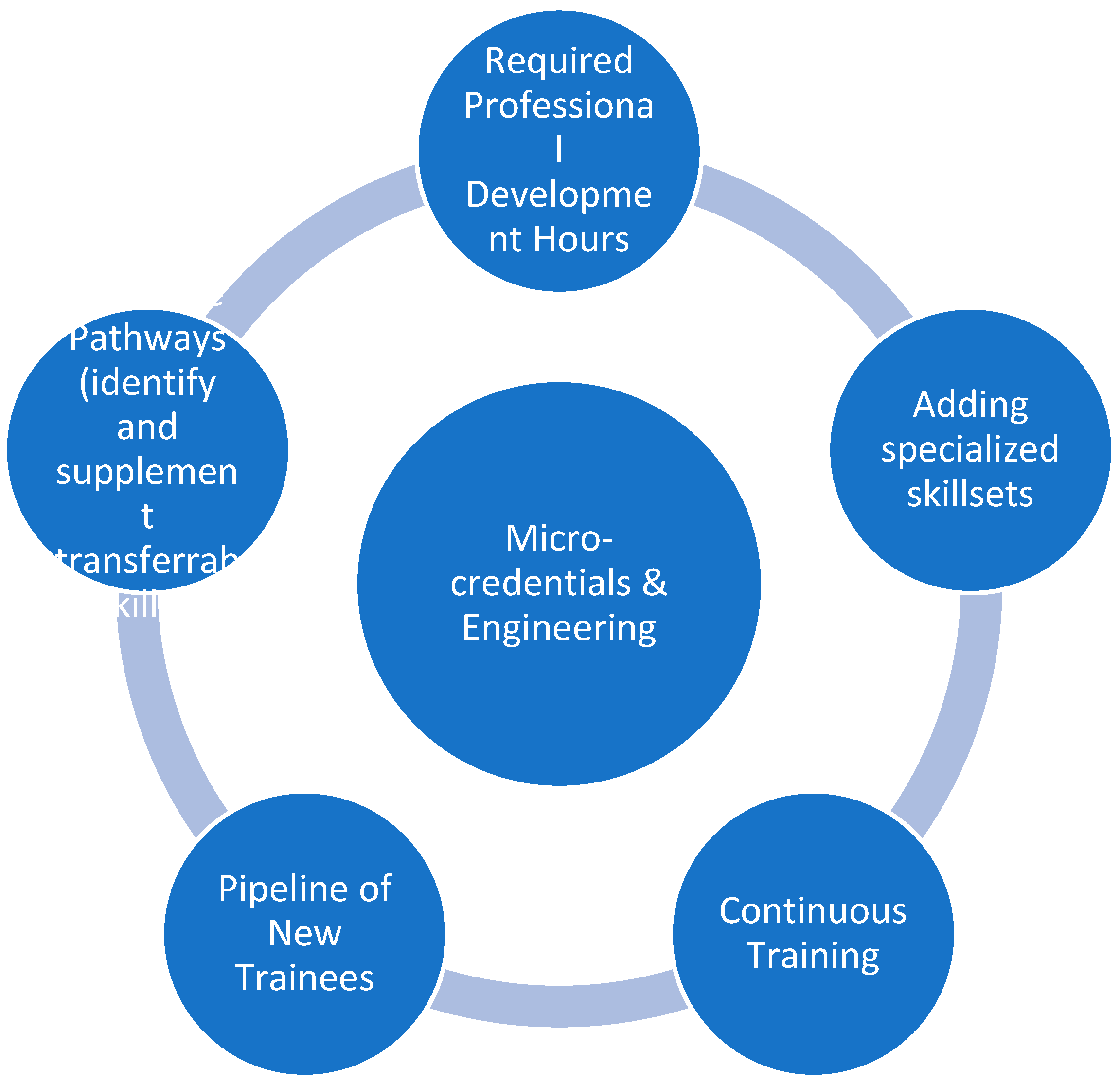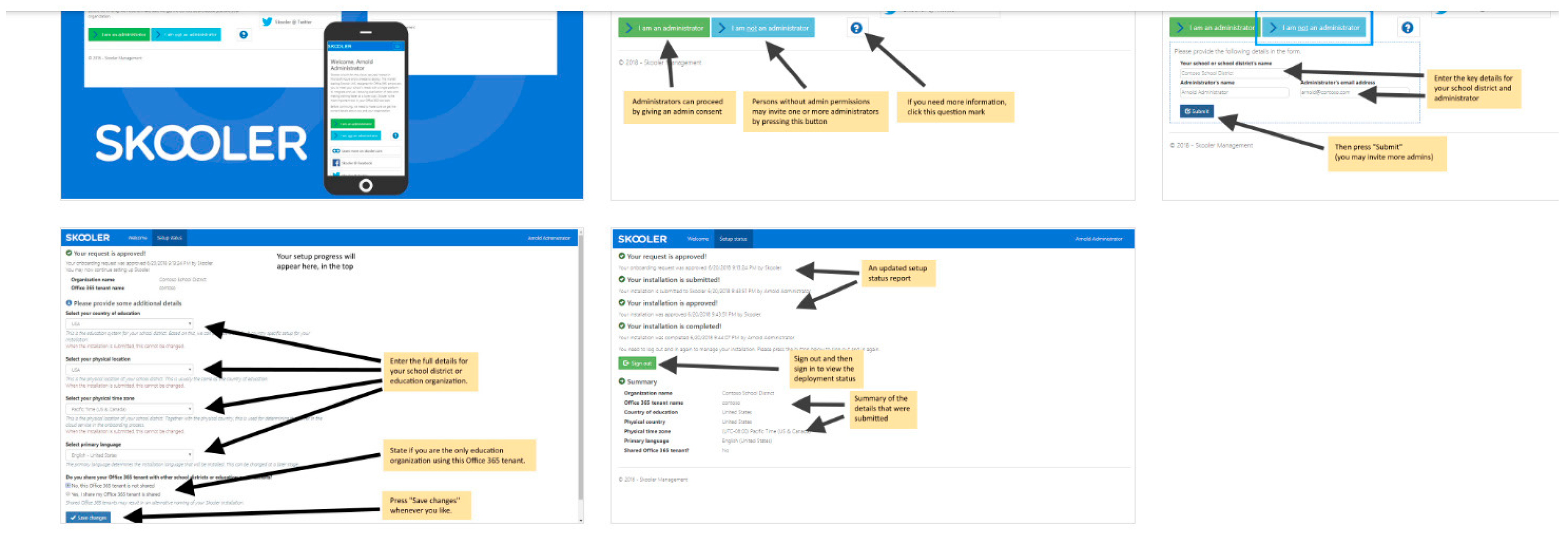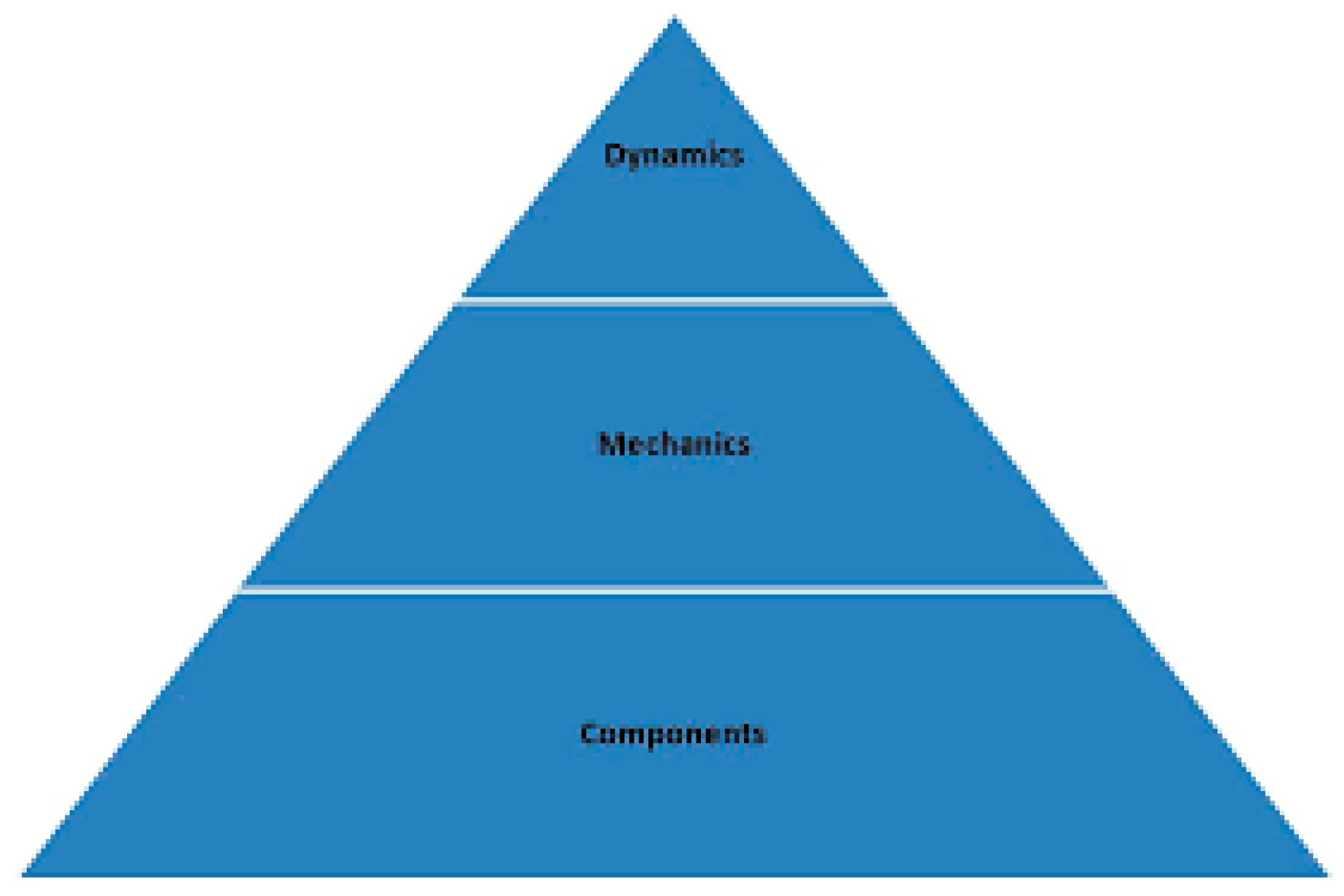Background
Gamification is the integration of game mechanics into a non-game environment (
Deterding, 2012). This practice takes advantage of the features that make a game fun, to enhance the engagement of the user (
Triantafyllou & Georgiadis, 2022a). Therefore, depending on whether the user of a gamified application participates in the learning process, his/her experience is enhanced.
A key feature of the game’s strategy is reward. This particular technique is applied to gamified projects through goals and rewards (
Triantafyllou & Georgiadis, 2022b). Each time a user completes a goal, the reward could be to earn a badge. Such reward examples are illustrated by point counting, badges, progress bars, and even virtual coins. This technique significantly encourages the involvement of the user, as it meets his/her internal need for recognition of his/her effort, and increases his/her degree of loyalty.
Gamification is a technology used in both teaching and assessment. The gamification of learning aims to increase the student’s involvement with the learning material (
Seaborn & Fels, 2015), as well as to increase the degree of "student engagement", while in the long term it is able to instill behaviors that will favor the acquisition of knowledge and correct social interactions (
Furdu, I., Tomozei, C., & Köse, 2017).
Approach
According to
Kevin Werbach (
2012), the three basic features of a gamified software system are the dynamics, mechanics and components as shown in the form of a pyramid structure (see
Figure 1). The dynamics constitute the basis of the game. The mechanics are the processes involved in the development of the game. Game mechanics can be categorized in the following form: (i) behaviour mechanics with focus on human behaviour and the human psychology, (ii) feedback mechanics with emphasis on the cycle feedback of gameplay, (iii) progression mechanics that constitute a set of important skills that users should develop. The components are the specific dynamics and mechanics applied to the software system such as badges, points, avatars, leaderboards, virtual goods, etc. The most well-known and used components are badges, points and leaderboards (
Werbach, 2012). These components are applied to a non-game context and the gamified system is developed with main aim to enhance motivation of users to participate in the learning process and complete successfully the pre-designed set of learning tasks.
Motivation is acknowledged to be one of the most important predictors of learners’ performance in learning. Self-Determination is a theory of human motivation developed by psychologists Edward Deci and Richard Ryan. The key point of this theory is to examine what motivates a person to act. According to this theory each learner has three basic needs and only when these needs are satisfied the individual can have a better performance in learning. These needs are: (a) autonomy, (b) competence and (c) belongingness. The need of autonomy is the need to experience behavior as voluntary and give learners autonomy choosing the content they want to study (
Niemiec & Ryan, 2009). The need of competence which means the need to experience behaviors as effectively enacted (
Niemiec & Ryan, 2009). The need of belongingness which means learners’ need to have meaningful relationships and interactions with other peers (
Baumeister & Leary, 1995).
Micro-credentials are increasing in visibility and importance on the national and international stage, with a new EU Commission report published this week emphasizing their role in supporting lifelong learning and employability (
“Why engineers are choosing micro-credentials to keep pace with industry developments”, n.d.). We will discuss the topic of Micro-credentials, which are gaining momentum globally. A micro-credential is a qualification, providing evidence of learning outcomes acquired through a short learning experience. Innovative educators try to find new ways to deliver knowledge in a way that makes sense, at every stage of learner’s progression. Knowledge should be delivered in flexible ways to learner groups with main aim to bridge and leverage of what learners already know. Therefore, learners are more encouraged to construct new knowledge according to their prior learning experiences (see
Figure 2).
A recent paper, by researchers from Vanderbilt University in the Journal of Learning Sciences, shows that students who played games as part of their regular curriculum were more engaged in class work (
Clark, Tanner-Smith, Hostetler, Fradkin & Polikov, 2017). An excellent application of online games takes place at Hofstra University on Long Island in New York. Via the Game Builders Academy (GBA) which is a digital game-based learning for science, technology, engineering, and math [science, technology, engineering, and math (STEM)], learners have the opportunity to learn math, science, technology, critical thinking, problem solving and more, all through video game development.
Skooler is also a set of tools within Office 365 that turns it into a full Learning portal for all K-12 schools and school districts. Using Skooler, teachers can work with education-relevant elements like assignments, assessment, quizzes, absence and grade books related to their students (see
Figure 3). Students can follow their homework and perform other educational activities using known Office 365 applications like Word, OneNote and Teams (
“Skooler Learning Tools”, n.d.). Skooler introduced the mConnect app, which gives the nearly 200 million Moodle users at more than 150,000 educational institutions worldwide the ability to use Moodle and Teams together in one seamless workspace with a single sign-on. Skooler’s intuitive tools help connect teachers, students, and parents to achieve strong educational results.
Actual or anticipated outcomes
The traditional approach where teaching is the same for all individuals has become an obsolete concept. It seems that personalized learning is the new pathway to achieving excellence. The unprecedented changes that education experienced during the pandemic (COVID-19) raised questions about what teaching should look like and what curricula should look like. Personalized learning and its potential to transform education is a topic of great interest and has lot to offer for the good of education in the future. Gamification refers to adding game elements to a course such as leaderboards, badges, trophies, and achievements, without making underlying changes to the design of the course. Gamification can open new pathways in personalized learning with many positive learning outcomes. Gameful pedagogy goes farther building game elements into the design of the course, such as building up points from zero, user choice, immediate feedback, learning from failure, and transparency.
References
- Baumeister, R., and M. R. Leary. 1995. The need to belong: Desire for interpersonal attachments as a fundamental human motivation. Psychological Bulletin 117: 497–529. [Google Scholar] [CrossRef] [PubMed]
- Clark, D., E. Tanner-Smith, A. Hostetler, A. Fradkin, and V. Polikov. 2017. Substantial Integration of Typical Educational Games Into Extended Curricula. Journal Of The Learning Sciences 27, 2: 265–318. [Google Scholar] [CrossRef]
- Cook, W. (2013). Training Today: 5 Gamification Pitfalls. Training Magazine. Retrieved from: http://www.ainingmag.com/content/training-today-5-gamification-pitfall.
- Deterding, S. 2012. Gamification: Designing for Motivation. Interactions 19: 14–17. [Google Scholar] [CrossRef]
- Furdu, I., C. Tomozei, and U. Kose. 2017. Pros and cons gamification and gaming in classroom. arXiv preprint arXiv:1708.09337. [Google Scholar]
- Niemiec, C. P., and R. M. Ryan. 2009. Autonomy, competence, and relatedness in the classroom: Applying self-determination theory to educational practice. Theory and Research in Education 7: 133–144. [Google Scholar] [CrossRef]
- Triantafyllou, S., and C. K. Georgiadis. 2022a. Gamification of MOOCs and security awareness in corporate training. [Google Scholar] [CrossRef]
- Triantafyllou, S. A., and C. K. Georgiadis. 2022b. Gamification Design Patterns for user engagement. Informatics in Education 21, 4: 655–674. [Google Scholar] [CrossRef]
- Werbach, K. 2012. For the Win: How Game Thinking Can Revolutionize Your Business. Wharton: Wharton Digital Press. [Google Scholar]
- Seaborn, K., and D. I. Fels. 2015. Gamification in theory and action: A survey. International Journal of human-computer studies 74: 14–31. [Google Scholar] [CrossRef]
- Skooler Learning Tools. Retrieved from: https://appsource.microsoft.com/en-us/product/web-apps/skooler.skoolerlms?tab=overview.
- Why engineers are choosing micro-credentials to keep pace with industry developments. Retrieved from: https://www.engineersireland.ie/Engineers-Journal/More/Sponsored/why-engineers-are-choosing-micro-credentials-to-keep-pace-with-industry-developments.
|
Disclaimer/Publisher’s Note: The statements, opinions and data contained in all publications are solely those of the individual author(s) and contributor(s) and not of MDPI and/or the editor(s). MDPI and/or the editor(s) disclaim responsibility for any injury to people or property resulting from any ideas, methods, instructions or products referred to in the content. |
© 2023 by the authors. Licensee MDPI, Basel, Switzerland. This article is an open access article distributed under the terms and conditions of the Creative Commons Attribution (CC BY) license (http://creativecommons.org/licenses/by/4.0/).






